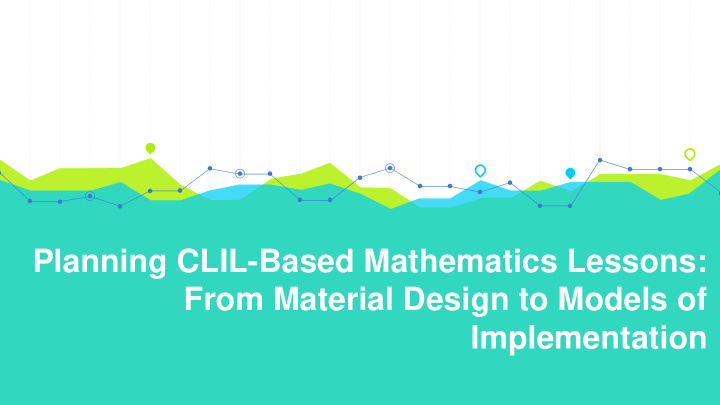



Planning CLIL-Based Mathematics Lessons: From Material Design to Models of Implementation
Let’s start with the underlying principles of the approach 1 Content and Language Integrated Learning 2
Ou Outl tline ine How to Put CLIL What is CLIL? into Practice? Who are Why CLIL? engaged? CLIL When to Where do people implement it? implement it?
Retrieved from: http://conference.jaltcue.org/wp-content/uploads/2016/10/2016-JALT-CUE- CLIL_MakotoIkeda.pdf 4
Guy Cook’s “revolutions” in ELT Approx. time line: 1850 1900 1950 1970 2000 2010 Based on Cook 2010:22; Ikeda: 2019 5
What is CLIL? “ CLIL refers to situations where subjects, or parts of subjects, are taught through a foreign language with dual-focused aims , namely the learning of content, and the simultaneous learning of a foreign language. (Marsh, 1994) 6
The 4Cs Framework by Do Coyle Content or Micro vs. Communication Culture Macro Soft CLIL vs. Hard CLIL Bloom’s Communication Cognition revised or Content Taxonomy 7
Cognition 8
Communication 9
Langue vs . Parole Learn to use the Use the language to language (accuracy) learn (fluency) Content Language Language Language Thinking
Who are engaged? Teachers Policy Makers Learners Staff Researchers 11
When to implemented? Any age: From a single K-12, college, lesson to weeks, adults or a program Prepare and Plan 12
CLIL on the Map 13
Why CLIL? Wouldn’t you prefer it if your students could leave being able to speak about probability rather than present perfect? 14
CLIL VS. Future Skills (21 ST Century) Cogni ogniti tion on vs. s. Cre reativi ativity ty Com ommuni unication cation Collabo laboration ion vs. s. vs. s. Comm ommuni unication cation Individual ual constru tructi ction on Cont ntent nt vs. s. Cri ritical tical Cultu ture re vs. s. Citi tizensh zenship Think nking ing
WHAT WE WOULD LIKE TO SHARE? 2 Content and Language Integrated Learning 16
CLIL CL L Mat ath h Mat ateria erials ls How did we start it? ◉ How did we revise it? ◉ How does it look like? ◉ ◉ What are we going to do next? 17
CLIL Material Design Zone 01 Zone 02 A theme/ Zone 03 Language use topic Zone 04 & Task activation Collaboration Design Content & Competency Communication CLIL materials Cognition Culture
CLIL Lesson Plan Worksheet Content Communication Cognition Culture Declarative Language Lower-order Cooperative knowledge knowledge thinking skills learning Procedural Language skills Higher-order Global knowledge thinking skills Awareness ( by Ikeda, 2019) 19
CLIL Lesson Plan: Contingency Tables 20
4Cs vs. Contingency Tables Content Cognition Organize data from Get a basic picture of the different random variables interrelation between two variables Identify different percentage-based Make a contingency table observations Communication Community/ Culture Common seafood Respect different Expressions of preferences preferrences Collaborate with classmates Compasion to solve problems. 21
Content first? 22
From: Teaching Maths through English – a CLIL approach 23
Models of Implementation Teachers: Researchers: Math & English Math & English 24
OUR PROCESS IS EASY Data Da ta co collection lection Collab laboratio oration n Feedbac ack k and read ading ing and nd Disc scus ussio sions ns and nd Revi visio sions ns 25
26
THANKS! Any questions? 27
Recommend
More recommend